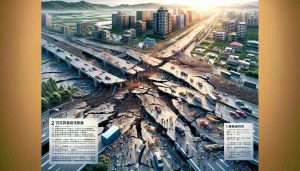Massive quake rattles Taiwan! A 6.4 magnitude earthquake struck near Chiayi, leading to evacuations and minor damage. Occurring in the early hours, the quake’s epicenter was located in Dapu township, a rural area in southern Taiwan. With a depth of 6 miles, the tremor sent ripples through buildings as far as the capital, Taipei.
The Taiwan Semiconductor Manufacturing Company (TSMC), a key player in the tech industry, acted swiftly to ensure employee safety by evacuating staff from their facilities situated in both central and southern regions of the island. Fortunately, all employees were reported safe after the quake.
In the city of Tainan, emergency responders reported that some individuals were trapped in damaged structures, but many have since been rescued. Authorities have been actively assessing the situation, and while there were reports of power outages in some remote villages, there were no significant injuries or major devastation noted.
Historically, Taiwan is located at the convergence of two tectonic plates, making it susceptible to seismic activity. The region remembers severe earthquakes, such as the 1906 Meishan quake, which resulted in tragic losses. The latest quake serves as a reminder of the natural forces that can impact this island nation.
Aftershocks: Understanding the Broader Implications of Seismic Activity in Taiwan
The recent 6.4 magnitude earthquake near Chiayi has not only disrupted daily life but also highlights the broader implications of seismic events in Taiwan. As a critical hub for the global tech industry, disruptions in such a strategic location can ripple through international supply chains. The Taiwan Semiconductor Manufacturing Company (TSMC), responsible for supplying chips to companies like Apple and Nvidia, showcases how quickly local earthquakes can escalate into global economic concerns.
Culturally, these natural disasters evoke a deep historical resilience among the Taiwanese. Past events have fostered a collective memory that shapes the island’s approach to disaster preparedness, influencing both community behavior and government policy. While the immediate focus remains on recovery, local culture deeply informs strategies surrounding urban planning and infrastructure development, aiming to mitigate damage in the future.
The environmental impacts also warrant attention. Repeated seismic activity has the potential to alter landscapes, affect ecosystems, and even trigger landslides, particularly in rural areas. Over time, this could lead to changes in biodiversity and land use patterns.
Looking ahead, Taiwan’s proactive earthquake response could set a model for other earthquake-prone regions. As climate change exacerbates natural disasters, investments in resilient infrastructure and public awareness will be essential in safeguarding the community and the economy from future seismic threats.
Taiwan Earthquake: The 6.4 Magnitude Tremor and Its Implications
Overview of the Earthquake
On a recent early morning, Taiwan experienced a significant 6.4 magnitude earthquake near Chiayi, which resulted in immediate evacuations and underscored the seismic risks inherent to the island nation. The quake’s epicenter was identified in Dapu township, sitting at a shallow depth of 6 miles. This level of intensity was felt as far away as Taipei, causing concerns among residents and authorities alike.
Immediate Response and Safety Measures
In the aftermath of the quake, the Taiwan Semiconductor Manufacturing Company (TSMC), one of the island’s major employers and a global leader in semiconductor production, took proactive measures to evacuate employees from their facilities in central and southern Taiwan. Fortunately, all employees were confirmed safe, showcasing the effectiveness of safety protocols in place at critical tech facilities.
Impact on Urban Areas
In Tainan, emergency responders were deployed swiftly to assess damages and rescue trapped individuals from compromised structures. Fortunately, thanks to quick action, many individuals have since been rescued, with extensive support from local authorities. Power outages were reported in some remote villages, though no significant injuries or widespread destruction have been confirmed.
Geological Context and Historical Significance
Taiwan is situated at the intersection of the Philippine Sea Plate and the Eurasian Plate, making it one of the most seismically active areas in the world. The island has a history of severe seismic events, such as the 1906 Meishan earthquake that caused extensive damage and loss of life. Understanding the geological context highlights the ongoing risks that inhabitations in Taiwan must contend with, fostering a culture of preparedness and resilience.
Safety Preparedness and Community Awareness
1. Emergency Kits: Residents are encouraged to prepare emergency kits, including food, water, medical supplies, and necessary documents, to sustain themselves in case of future seismic events.
2. Evacuation Plans: Communities should have clear evacuation plans that are regularly communicated and practiced to ensure swift action when required.
3. Building Inspections: Post-quake, it is vital for buildings and infrastructures to undergo inspections to assess any damages, ensuring public safety and structural integrity before reoccupation.
Current Trends and Future Predictions
As the scientific community continues to study Taiwan’s seismic activity, advances in earthquake prediction technology are being developed. Enhanced monitoring systems around the Pacific Ring of Fire aim to provide better warnings and reduce risks.
Conclusion
The recent earthquake near Chiayi has reignited conversations about Taiwan’s readiness for such natural disasters. While the immediate aftermath demonstrated effective emergency response and safety protocols, it also emphasizes the need for ongoing community education and preparedness for future seismic events.
For further insights into Taiwan’s seismic activities and safety protocols, visit Central Weather Bureau.








More Stories
Trump’s Second Term Promises Major Changes! Expect Big Shifts in Immigration Policy
Justin Timberlake’s Secret Weapon for Unforgettable Concerts
Love, Drama, and Laughter Await! Discover the World of ‘XO, Kitty’